Efficient Key Agreement Algorithm for Wireless Body Area Networks Using Reusable ECG-Based Features
Abstract
:1. Introduction
2. Related Work
2.1. Physiological Signal
2.2. Key Agreement Methods
3. The Proposed Method
3.1. WBAN Topology and Wireless Standard
3.2. The Proposed Key Agreement Method
| Algorithm 1. The proposed method. |
| Step 1. Check the validation of the timer period |
| a) Check P-value |
| b) Start first connection if P = 0 |
| c) Start later connection if P ≠ 0 |
| Step 2. Start key agreement using the first connection procedure when P = 0 |
| a) Start by sender and receiver having their feature vectors (i.e., FV1 and FV2, respectively) |
| b) The sender generates timer validation period P and sends P along with HFVS to the receiver, where HFVS = Hashing (FV1) |
| c) The receiver receives HFVS and starts to generate HFVR by Hashing (FV2). |
| d) The receiver checks the authenticity of the sender by comparing HFVS and HFVR |
| e) After checking the sender’s authenticity, the key generation process starts at the receiver side by generation OFVR, where OFVR= Ordering algorithm (FV2) |
| f) Receiver side security key is generated by hashing OFVR, Key R = Hash (OFVR) |
| g) To ensure that the key is not transmitted through a medium, only the hash of the key HK R will be sent to the sender to verify the key correction, where HK R= Hash (Key R) |
| h) The sender uses the same ordering method that was used by the receiver to generate OFVS |
| i) The sender generates the security key Key S by hashing OFVS |
| j) Sender then generates HK S by hashing its version of the security key. If HK s == HK R, then Key R and Key s will be used as encryption keys, and success acknowledgment will be sent to the receiver. |
| Step 3. Start key agreement using the later connection procedure when P ≠ 0 |
| a) The sender generates PM and uses it to produce a new version of its feature vector FV1 as following: FV new S =Permute (FV1, PM) |
| b) The sender generates its new security key for this session using FV new S as following Key new S = Hash (FV new S) |
| c) The sender generates a hash of the new generated key HK new S and sends it along with PM to the receiver |
| d) The receiver uses PM to generate FV new R as the following FV new R =Permute (FV2, PM) |
| e) The receiver generates its version of the session security key Key new R as following: Key new R = Hash (FV new R) |
| f) To check the validity of Key new R, the receiver generates HK new R by hashing Key new R |
| g) If the HK new R == HK new S, then Key new R and Key new s will be used to secure this session connection. If not, the first connection cycle will be started. |
3.2.1. First Connection Key Agreement Cycle
- 1)
- Collect ECG signal for at least 4 s with a high synchronization level.
- 2)
- Clean the collected signal with low/ high pass filters.
- 3)
- Partition signal samples into two overlapped equal-size windows.
- 4)
- Apply 256-points FFT and use only the first 128 FFT coefficients.
- 5)
- Apply peak detection function to the first 128 FFT coefficients. The peak detection function output is in the form of tuple <peak index, peak value>.
- 6)
- Quantize each peak index into binary number with 5-digits and each peak value into 8-digits binary number.
- 7)
- A 13- bit feature is constructed by a simple concatenation process between each quantized peak index and its corresponding quantized.
- 8)
- The final output will be a feature vector containing extracted quantized features.
3.2.2. Later Connection Key Agreement Cycle
| Example 1: The basic idea of the proposed method |
| Given: |
| Feature vector with the following values: |
| [1, 2, 5, 10, 12] |
| 1st connection key: |
| Key= hash (1 ||2||5||10||12) |
| 2nd connection key: |
| PM = [5, 3, 1, 4, 2] |
| Key new= hash (12 ||5 ||1 ||10 ||2) |
| Conclusion: |
| Altering the position of features will guarantee the freshness of the new session key. |
3.3. Timer Period Calculation and Key Refreshing Rate
4. Security Analysis
- First connection key agreement cycle: For the first connection cycle, the only keying information to be transferred in the communication medium is the hashing of the common key. The security of legitimate features is assured because features are not transmitted in the medium since two communicating ends collect the same signal and extract the same features. This will make feature identification a very hard task for an attacker. This paper assumes that sensors are secure and connection medium may not. Secure key transmission is assured by exchanging only MAC (i.e., hashing function) instead of the plain key. Key hashing knowledge is useless for the attacker’s key guessing process, because it cannot get hands-on features. The Nonce No usage maintains the connection’s freshness; hence, avoid using the old message to break the connection.
- Later connection key agreement cycle: The security of a later connection depends on the fact that there is no feature transmission on the communication medium. All the legitimate features are stored securely in communicating node memories. We assume that all sensors are under supervision, and no sensor can be compromised without being detected. Hence, the attacker can try key guessing using the information transmitted in the media. The only keying information to be exchanged is the key hash; the MAC of the key will ensure the key security. Knowing key hashing will add nothing to the attacker in the key guessing process. Key refreshing, even though the timer period is still valid, will help in making the attacker task harder. Even after the timer ends, all the information stored will be erased. This means a new first connection cycle; hence, updating of data to be guessed.
5. Experimental Results and Discussion
- Key Length and randomness: The generation of long and random security keys is ensured by using a one-way hashing function (i.e., MD5).
- Communication and feature transmission cost: The cost of the identification number for sender and receiver (i.e., IDs and IDr) is 16 bytes each. Connection refreshment number No is 16 bytes. Index I and permutation matrix PM are at most 1 byte. The timer validation period P is 1 byte, and MAC is 16 bytes. Here, features and noisy data points are represented by 12 or 13 bit each (i.e., about 1.5 bytes). For PBAKA, transaction information Ts and Tr are 20 bytes each. Table 6 shows that our algorithm offers the lowest communication overhead among the presented schemes.
- 3.
- Energy consumption: The sensor consumes 28.2 mJ to receive one byte and 59.2 mJ to transmit it [40]. As shown in Table 7, our algorithm gives the lowest energy consumption. We used the message size calculated earlier by communication overhead and calculates how many bytes will be transmitted and received during the agreement cycle. After counting the bytes for each method, we calculated the energy consumed, as illustrated by Table 7. Table 7 shows that the proposed method has the lowest energy consumption compared to other methods. The values of NFV are 1000, 3000, and 1000 for PKA, PSKA, and OPFKA, respectively. The value of Fs and Fr is 100.
- 4.
- Memory storage: Memory storage means the amount of memory consumed during the key agreement process. As we can see from the results in Table 8, our algorithm shows better memory storage results.
- 5.
- Distinctiveness: Distinctiveness means the ability of an algorithm to best discriminate between authorized sensors from unauthorized ones (i.e., distinguish sensors in the same WBAN from those in another WBAN). This can be achieved by using a modified version of FFT with a high synchronization level. High synchronization level ensures that only sensors that are willing to communicate in the same WBAN can connect securely.
- 6.
- Temporal variance: Higher temporal variance implies that signal’s better randomness. The higher the randomness, the harder it is getting to comprise network security. Signals collected at different times are generally unique. However, if the time difference between two successive signal readings is so close, the collected signal values will be similar [16]. The proposed method solves close readings/similar values problem and achieves better temporal variance than the other schemes. This is mainly by using period P.
- 7.
- Low latency: Sampling duration needed for secure key agreement highly depends on the physiological signal used [16]. As illustrated in the discussion section, when FFT is used to extract ECG signal, at least 4 s is needed with 128 Hz sampling rate. PBAKA needs at least 12.6 s.
6. Conclusions and Future Work
Author Contributions
Funding
Data Availability Statement
Conflicts of Interest
References
- Venkatasubramanian, K.K.; Gupta, S.K.S. Security for Pervasive Health Monitoring Sensor Applications. In Proceedings of the 2006 Fourth International Conference on Intelligent Sensing and Information Processing, Bangalore, India, 15 October–18 December 2006; pp. 197–202. [Google Scholar]
- Tobón, D.P.; Falk, T.H.; Maier, M. Context awareness in WWBANs: A survey on medical and non-medical applications. IEEE Wirel. Commun. 2013, 20, 30–37. [Google Scholar] [CrossRef]
- O’Donoghue, J.; Herbert, J.; Sammon, D. Patient Sensors: A Data Quality Perspective. In Proceedings of the International Conference on Smart Homes and Health Telematics (ICOST 2008), Ames, IA, USA, 28 June–2 July 2008; pp. 54–61. [Google Scholar]
- O’Donoghue, J.; Herbert, J. Data Management within mHealth Environments. J. Data Inf. Qual. 2012, 4, 1–20. [Google Scholar] [CrossRef]
- Lai, D.T.H.; Begg, R.K.; Palaniswami, M. Healthcare Sensor Networks: Challenges towards practical implementation; CRC Press: Boca Raton, FL, USA, 2011. [Google Scholar]
- O’Donoghue, J.; Herbert, J.; Fensli, R.; Dineen, S. Sensor Validation within a Pervasive Medical Environment. In Proceedings of the 2006 5th IEEE Conference on Sensors, Daegu, Korea, 22–25 October 2006. [Google Scholar] [CrossRef]
- Boyd, C. On key agreement and conference key agreement. In Proceedings of the Australasian Conference on Information Security and Privacy (ACISP 1997), Sydney, Australia, 7–9 July 1997; pp. 294–302. [Google Scholar]
- Kumar, P.; Lee, S.-G.; Lee, H.-J. E-SAP: Efficient-Strong Authentication Protocol for Healthcare Applications Using Wireless Medical Sensor Networks. IEEE Sens. J. 2012, 12, 1625–1647. [Google Scholar] [CrossRef] [PubMed] [Green Version]
- Jana, S.; Premnath, S.N.; Clark, M.; Kasera, S.K.; Patwari, N.; Krishnamurthy, S.V. On the effectiveness of secret key extraction from wireless signal strength in real environments. In Proceedings of the 15th Annual International Conference on Mobile Computing and Networking (MobiCom 09), Beijing, China, 20–25 September 2009; pp. 321–332. [Google Scholar]
- Diffie, W.; Hellman, M. New directions in cryptography. IEEE Trans. Inf. Theory 1976, 22, 644–654. [Google Scholar] [CrossRef] [Green Version]
- Du, W.; Deng, J.; Han, Y.S.; Varshney, P.K.; Katz, J.; Khalili, A. A pairwise key pre-distribution scheme for wireless sensor networks. ACM Trans. Inf. Syst. Secur. 2005, 8, 228–258. [Google Scholar] [CrossRef] [Green Version]
- Wilhelm, M.; Martinovic, I.; Schmitt, J. Secure Key Generation in Sensor Networks Based on Frequency-Selective Channels. IEEE J. Sel. Areas Commun. 2013, 31, 1779–1790. [Google Scholar] [CrossRef] [Green Version]
- Chen, Y.; Ge, Y.; Wang, W.; Yang, F. A Biometric-based User Authentication and Key Agreement Scheme for Heterogeneous Wireless Sensor Networks. KSII Trans. Internet Inf. Syst. 2018, 12, 1779–1798. [Google Scholar]
- Hei, X.; Du, X. Biometric-based two-level secure access control for Implantable Medical Devices during emergencies. In Proceedings of the IEEE Annual Joint Conference: INFOCOM, IEEE Computer and Communications Societies, Shanghai, China, 10–15 April 2011; pp. 346–350. [Google Scholar]
- Venkatasubramanian, K.K.; Banerjee, A.; Gupta, S.K.S. PSKA: Usable and Secure Key Agreement Scheme for Body Area Networks. IEEE Trans. Inf. Technol. Biomed. 2009, 14, 60–68. [Google Scholar] [CrossRef] [PubMed]
- Hu, C.; Cheng, X.; Zhang, F.; Wu, D.; Liao, X.; Chen, D. OPFKA: Secure and efficient Ordered-Physiological-Feature-based key agreement for wireless Body Area Networks. In Proceedings of the IEEE Annual Joint Conference: INFOCOM, IEEE Computer and Communications Societies, Turin, Italy, 14–19 April 2013; pp. 2274–2282. [Google Scholar]
- Venkatasubramanian, K.K.; Banerjee, A.; Gupta, S.K. EKG-based key agreement in Body Sensor Networks. In Proceedings of the IEEE Conference on Computer Communications Workshops, INFOCOM Wksps, Phoenix, AZ, USA, 13–18 April 2008; pp. 1–6. [Google Scholar]
- Available online: https://en.wikipedia.org/wiki/Electrocardiograpy (accessed on 4 February 2021).
- Karimian, N.; Guo, Z.; Tehranipoor, M.; Forte, D. Highly Reliable Key Generation from Electrocardiogram (ECG). IEEE Trans. Biomed. Eng. 2016, 64, 1400–1411. [Google Scholar] [CrossRef]
- Arefin, T.; Ali, M.H.; Haque, A.K.M.F. Wireless Body Area Network: An Overview and Various Applications. J. Comput. Commun. 2017, 5, 53–64. [Google Scholar] [CrossRef] [Green Version]
- Pan, J.; Tompkins, W.J. A Real-Time QRS Detection Algorithm. IEEE Trans. Biomed. Eng. 1985, BME-32, 230–236. [Google Scholar] [CrossRef] [PubMed]
- Hu, R.; Duan, X.; Jiang, H.; Zeng, P.; Jiang, Y. Pair-Wise Key Pre-Distribution Scheme for Wireless Sensor Networks. In Proceedings of the 2012 8th International Conference on Wireless Communications, Networking and Mobile Computing, Shanghai, China, 21–23 September 2012. [Google Scholar] [CrossRef]
- Rasheed, A.; Mahapatra, R.N. Key Predistribution Schemes for Establishing Pairwise Keys with a Mobile Sink in Sensor Networks. IEEE Trans. Parallel Distrib. Syst. 2010, 22, 176–184. [Google Scholar] [CrossRef]
- Fu, J.; Li, Q.; Li, S.; Ssanyu, L. A modified q-composite random key pre-distribution scheme based on kryptograph. In Proceedings of the 2010 International Conference on Computer Application and System Modeling (ICCASM 2010), Taiyuan, China, 22–24 October 2010. [Google Scholar] [CrossRef]
- Di Mauro, A.; Dragoni, N. Adaptive Multipath Key Reinforcement for Energy Harvesting Wireless Sensor Networks. Procedia Comput. Sci. 2015, 63, 48–55. [Google Scholar] [CrossRef] [Green Version]
- Liu, H.; Yang, J.; Wang, Y.; Chen, Y. Collaborative secret key extraction leveraging Received Signal Strength in mobile wireless networks. In Proceedings of the IEEE Annual Joint Conference: INFOCOM, IEEE Computer and Communications Societies, Orlando, FL, USA, 25–30 March 2012. [Google Scholar] [CrossRef]
- Van Torre, P. Channel-Based Key Generation for Encrypted Body-Worn Wireless Sensor Networks. Sensors 2016, 16, 1453. [Google Scholar] [CrossRef] [PubMed] [Green Version]
- Zhang, Z.; Wang, H.; Vasilakos, A.; Fang, H. Channel information based Cryptography and Authentication in Wireless Body Area Networks. In Proceedings of the 8th International Conference on Body Area Networks (BodyNets 13), Brussels, Belgium, 30 September–2 October 2013. [Google Scholar] [CrossRef]
- Mathur, S.; Trappe, W.; Mandayam, N.; Ye, C.; Reznik, A. Radio-telepathy: Extracting a Secret Key from an Unauthenticated Wireless Channel. In Proceedings of the 14th ACM International Conference on Mobile Computing and Networking (MobiCom 08), San Francisco, CA, USA, 14–19 September 2008; pp. 128–139. [Google Scholar]
- Sudarsono, A.; Yuliana, M.; Kristalina, P. A Reciprocity Approach for Shared Secret Key Generation Extracted from Received Signal Strength in The Wireless Networks. In Proceedings of the 2018 International Electronics Symposium on Engineering Technology and Applications (IES-ETA), Bali, Indonesia, 29–30 October 2018; pp. 170–175. [Google Scholar]
- Croft, J.; Patwari, N.; Kasera, S.K. Robust uncorrelated bit extraction methodologies for wireless sensors. In Proceedings of the 9th ACM/IEEE International Conference on Information Processing in Sensor Networks (IPSN 10), Stockholm, Sweden, 12–16 April 2010. [Google Scholar] [CrossRef] [Green Version]
- Patwari, N.; Croft, J.; Jana, S.; Kasera, S.K. High-Rate Uncorrelated Bit Extraction for Shared Secret Key Generation from Channel Measurements. IEEE Trans. Mob. Comput. 2009, 9, 17–30. [Google Scholar] [CrossRef]
- Brassard, G.; Salvail, L. Secret-Key Reconciliation by Public Discussion. In Proceedings of the Workshop on the Theory and Application of of Cryptographic Techniques (EUROCRYPT 1993), Lofthus, Norway, 23–27 May 1993; pp. 410–423. [Google Scholar]
- Venkatasubramanian, K.K.; Banerjee, A.; Gupta, S.K.S. Plethysmogram-based secure inter-sensor communication in Body Area Networks. In Proceedings of the 2008 IEEE Military Communications Conference (MILCOM 2008), San Diego, CA, USA, 16–19 November 2008. [Google Scholar] [CrossRef]
- Kumari, P.; Anjali, T. Symmetric-Key Generation Protocol (SGenP) for Body Sensor Network. In Proceeding of the 2018 IEEE International Conference on Communications Workshops (ICC Workshops), Kansas City, MO, USA, 20–24 May 2018; pp. 1–6. [Google Scholar]
- Tang, W.; Zhang, K.; Ren, J.; Zhang, Y.; Shen, X.S. Flexible and Efficient Authenticated Key Agreement Scheme for BANs Based on Physiological Features. IEEE Trans. Mob. Comput. 2018, 18, 845–856. [Google Scholar] [CrossRef]
- Juels, A.; Sudan, M. A fuzzy vault scheme. Des. Codes Cryptogr. 2006, 38, 237–257. [Google Scholar] [CrossRef]
- Nilsson, J.; Panizza, M.; Hallett, M. Principles of digital sampling of a physiologic signal. Electroencephalogr. Clin. Neurophysiol. Evoked Potentials Sect. 1993, 89, 349–358. [Google Scholar] [CrossRef]
- Goldberger, A.; Amaral, L.; Glass, L.; Hausdorff, J.; Ivanov, P.C.; Mark, R.; Stanley, H.E. PhysioBank, PhysioToolkit, and PhysioNet: Components of a new research resource for complex physiologic signals. Circulation 2000, 101, 215–220. [Google Scholar] [CrossRef] [PubMed] [Green Version]
- Ren, K.; Lou, W.; Zeng, K.; Moran, P.J. On Broadcast Authentication in Wireless Sensor Networks. IEEE Trans. Wirel. Commun. 2007, 6, 4136–4144. [Google Scholar] [CrossRef]
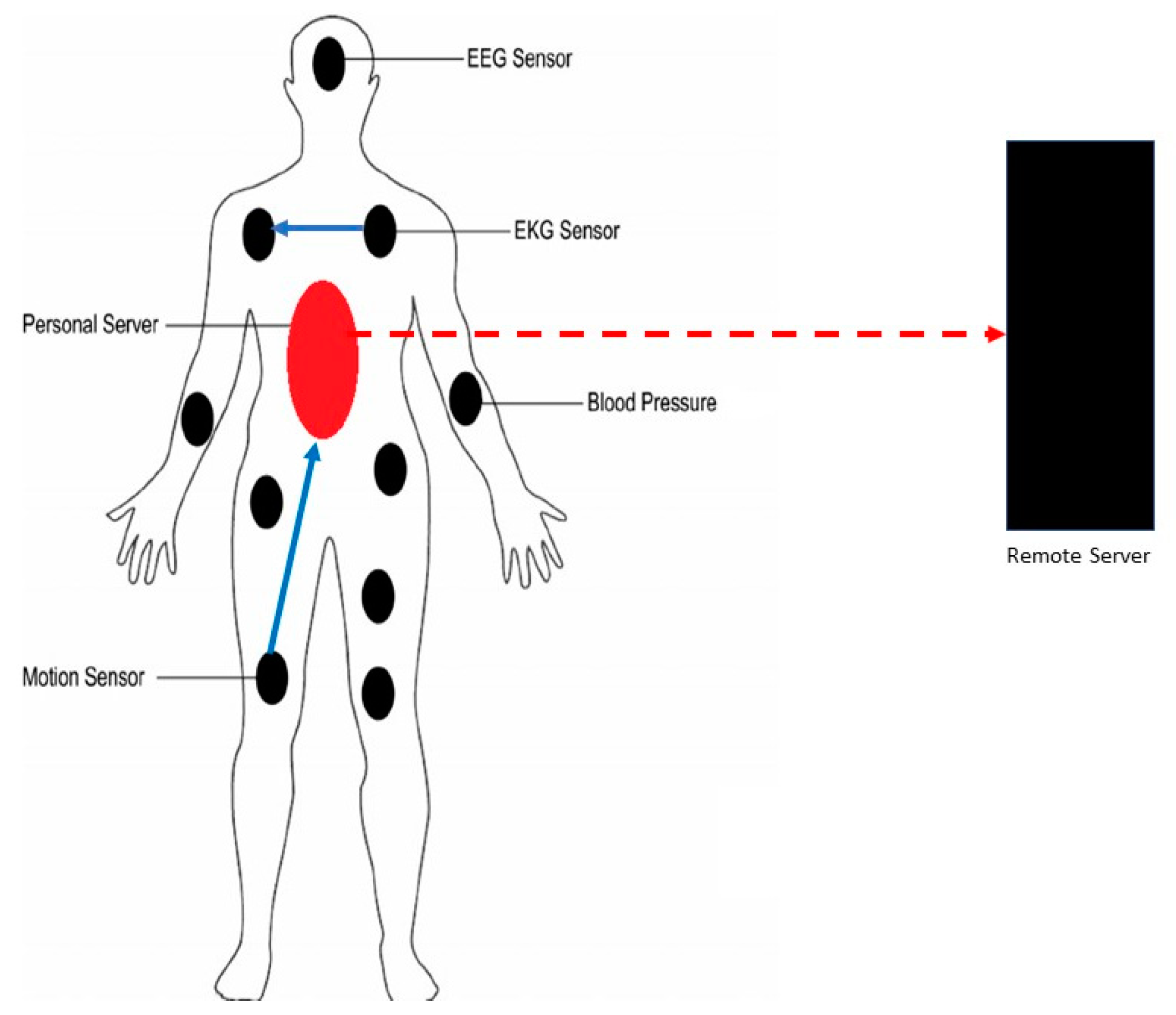

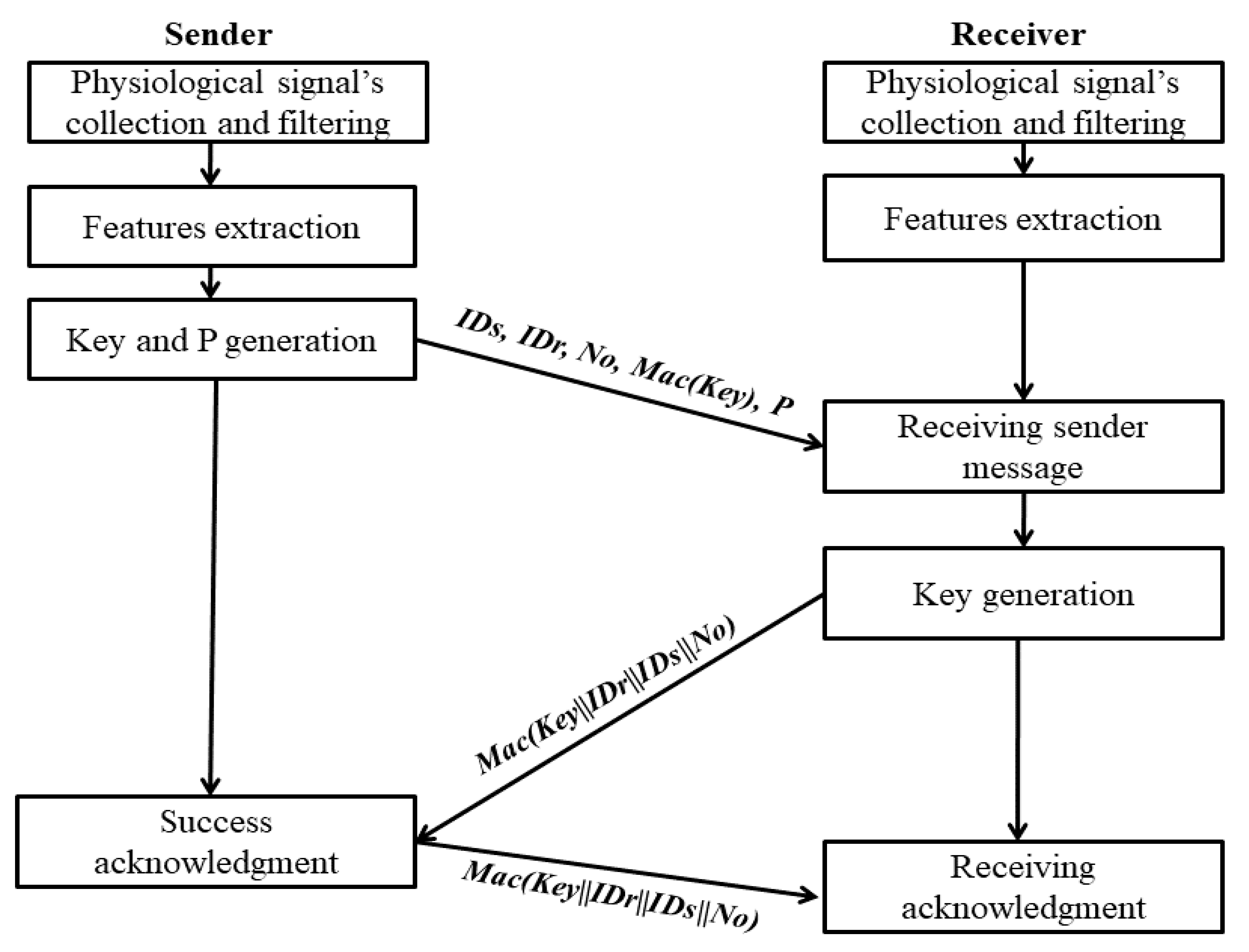
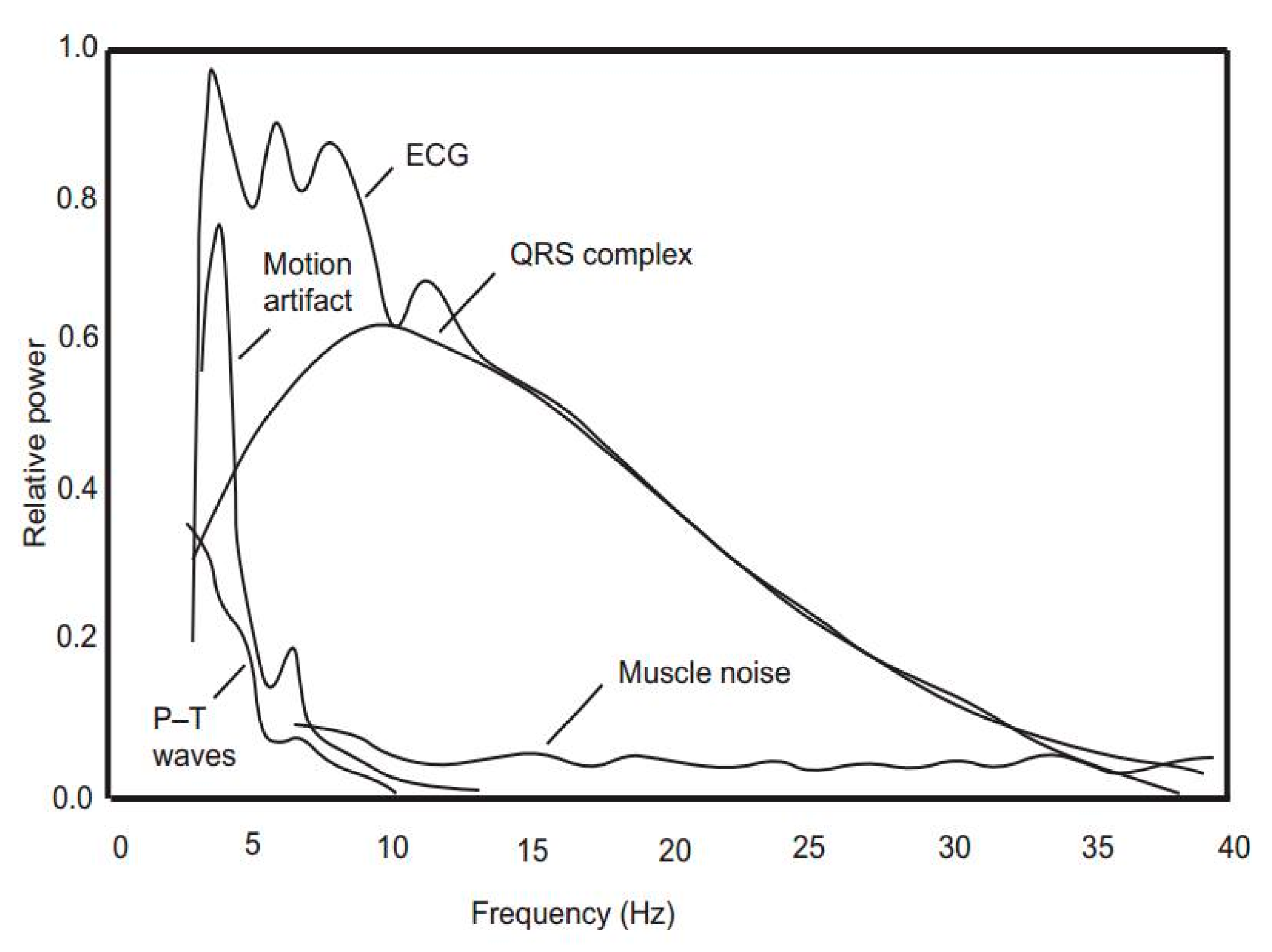


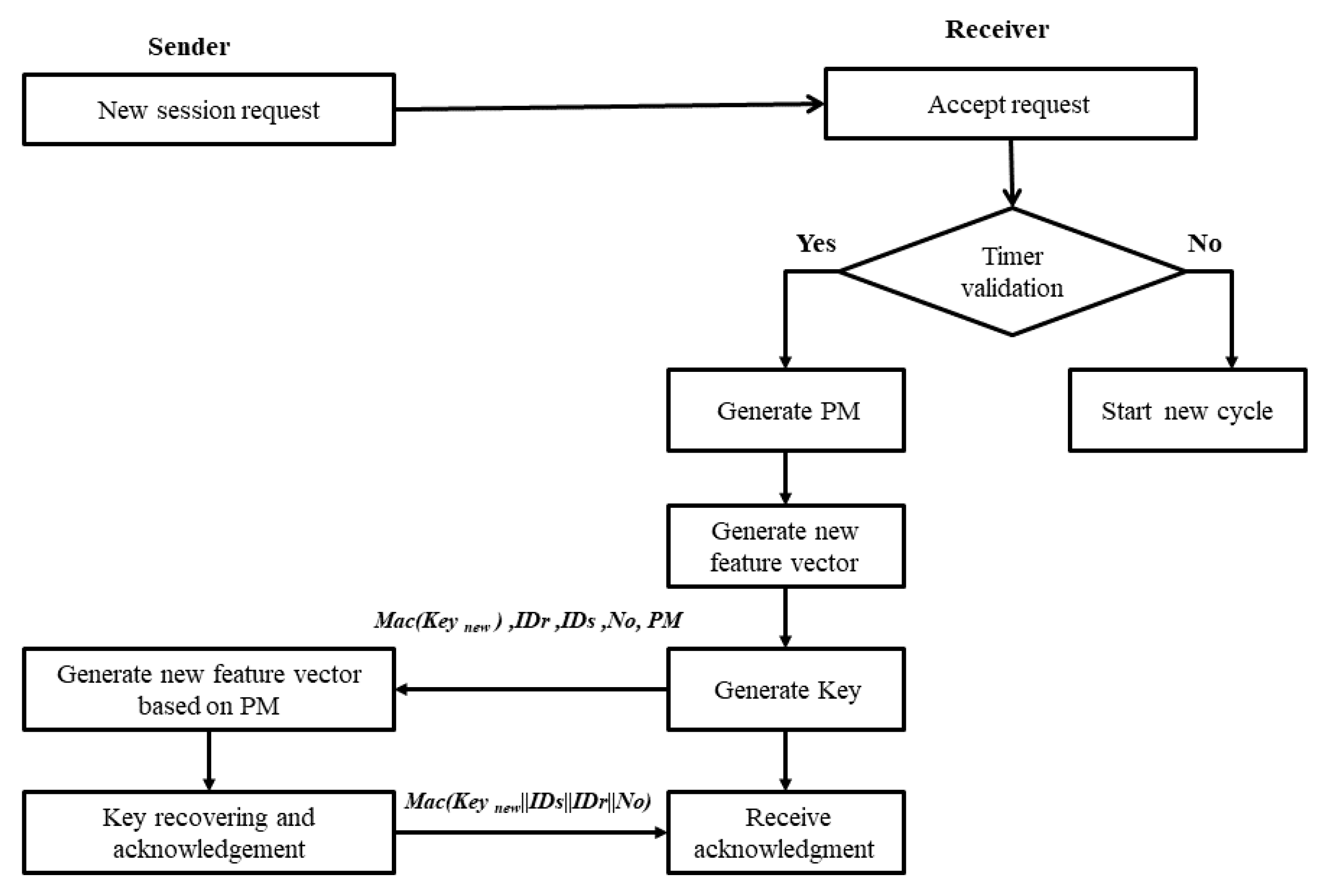
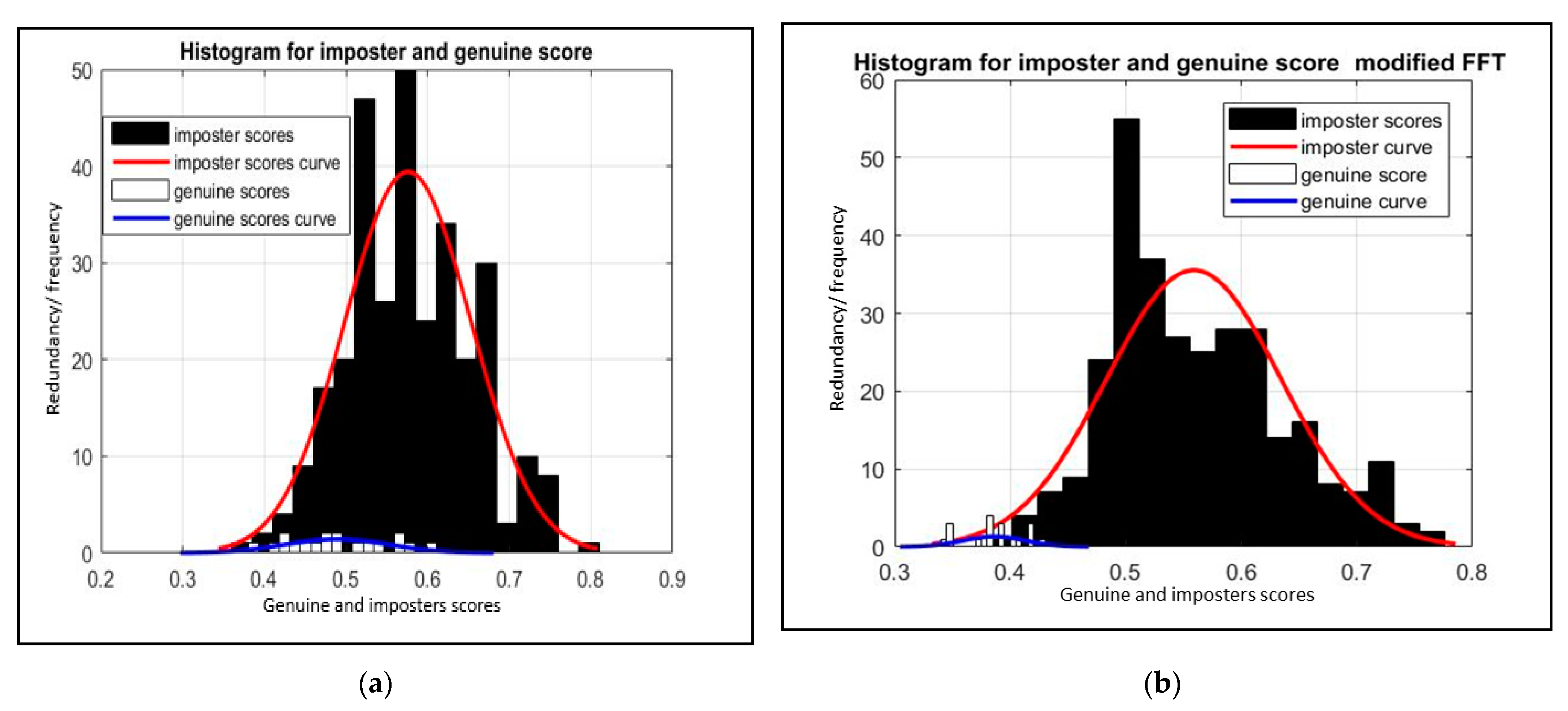
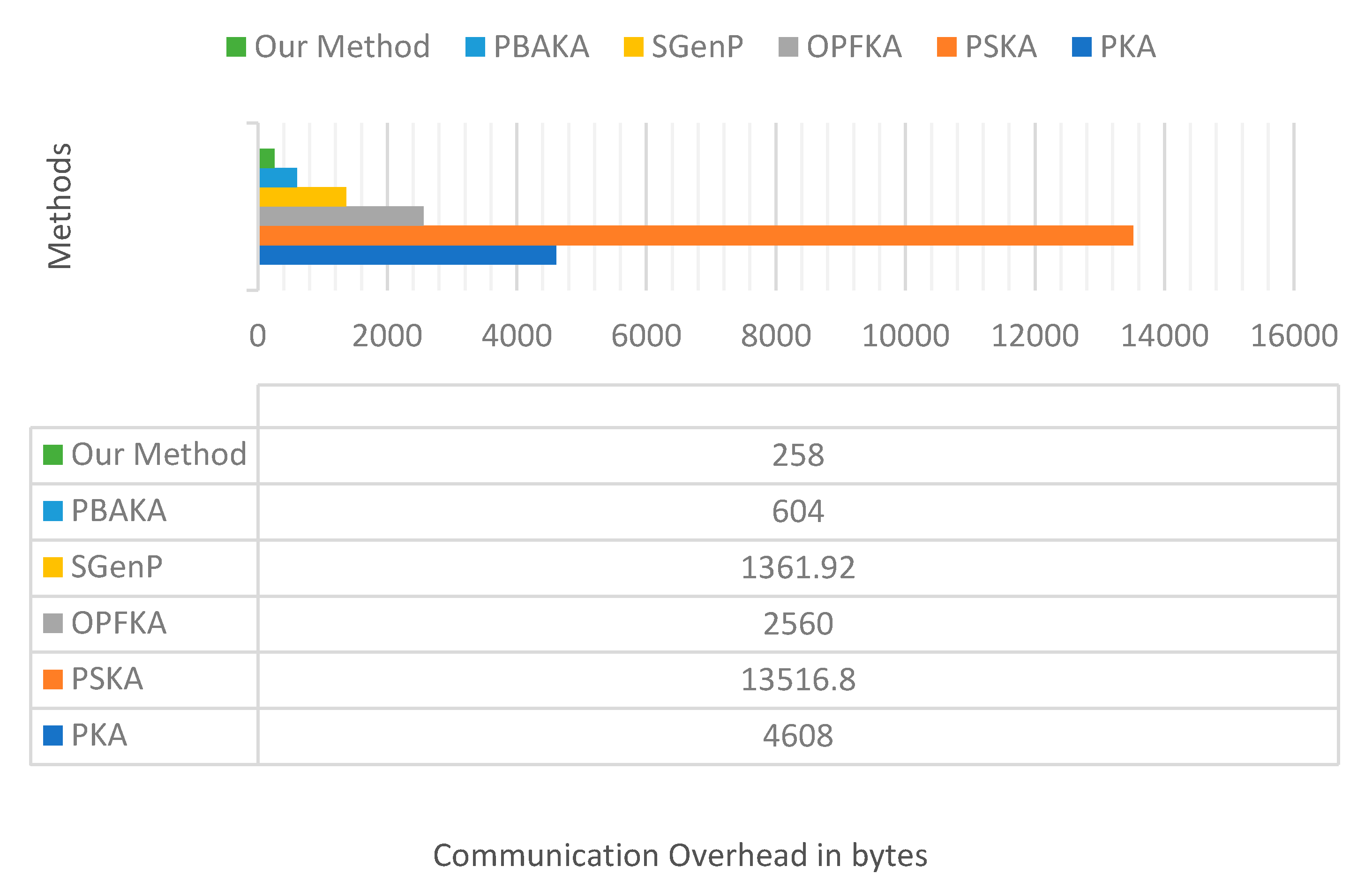


| Notation | Definition |
|---|---|
| HFV | Hashed feature vector |
| OFV | Ordered feature vector |
| HK | Hashed key |
| HKnew | New hashed key |
| IDs | Sender ID |
| IDr | Receiver ID |
| FVnew | New features vector |
| P | Period for timer validation |
| No | Nonce (i.e., Random number for transaction refreshment) |
| MAC | One-way hashing function |
| PM | Permutation matrix |
| || | Concatenate symbol |
| Key new | The new key generated based on PM |
| PLS | PLR | fc | P |
|---|---|---|---|
| 100 | 85 | 10 | 9 |
| 90 | 50 | 12 | 8 |
| 85 | 75 | 8 | 6 |
| 75 | 65 | 2 | 1 |
| 60 | 40 | 1 | 0 |
| 55 | 35 | 5 | 2 |
| 30 | 25 | 4 | 1 |
| 25 | 25 | 3 | 0 |
| 21 | 50 | 13 | NAN |
| ECG Length in Seconds | Sensitivity | Specificity | Efficiency | FAR | FRR | Accuracy | Error Rate |
|---|---|---|---|---|---|---|---|
| 4 | 0.7765 | 0.5185 | 0.7621 | 0.4815 | 0.2235 | 0.7879 | 0.2120 |
| 6 | 0.7944 | 0.4402 | 0.7747 | 0.5598 | 0.2056 | 0.7802 | 0.2198 |
| 8 | 0.7704 | 0.6212 | 0.7621 | 0.3788 | 0.2296 | 0.8602 | 0.1398 |
| 10 | 0.7783 | 0.5086 | 0.7633 | 0.4914 | 0.2217 | 0.8013 | 0.1987 |
| 12 | 0.7259 | 0.5196 | 0.7144 | 0.4804 | 0.2741 | 0.7671 | 0.2329 |
| ECG Length in Seconds | Sensitivity | Specificity | Efficiency | FAR | FRR | Accuracy | Error Rate |
|---|---|---|---|---|---|---|---|
| 4 | 0.7295 | 0.9087 | 0.7394 | 0.0913 | 0.2705 | 0.96974 | 0.0303 |
| 6 | 0.7909 | 0.9316 | 0.7987 | 0.0684 | 0.2091 | 0.9898 | 0.0102 |
| 8 | 0.7732 | 0.9491 | 0.7829 | 0.0509 | 0.2268 | 0.98207 | 0.0179 |
| 10 | 0.7956 | 0.9444 | 0.8039 | 0.0556 | 0.2044 | 0.99505 | 0.0050 |
| 12 | 0.7431 | 0.9744 | 0.7559 | 0.0256 | 0.2569 | 0.99159 | 0.0084 |
| Method | Sensitivity | Specificity | FAR | FRR | Accuracy | Error Rate |
|---|---|---|---|---|---|---|
| PKA | 0.7605 | 0.4131 | 0.2754 | 0.7807 | 0.2192 | |
| PSKA | 0.7861 | 0.5299 | 0.4701 | 0.2139 | 0.8047 | 0.1953 |
| OPFKA | 0.8750 | 0.5729 | 0.4271 | 0.1250 | 0.9317 | 0.0683 |
| SGenP | 0.8822 | 0.6724 | 0.3576 | 0.1478 | 0.9210 | 0.0790 |
| PBAKA | 0.8695 | 0.6271 | 0.3381 | 0.1144 | 0.9407 | 0.0593 |
| Our method | 0.7956 | 0.9444 | 0.0556 | 0.2044 | 0.9950 | 0.0050 |
| Method | First Connection | Later Connection | Message Size | Cost Analysis |
|---|---|---|---|---|
| PKA | 2|IDs| + 2|IDr| + 4.5|NFV| + |No| + 2|Mac| | 2|IDs| + 2|IDr| + 4.5|NFV| + |No| + 2|Mac| | 112 + 4.5|NFV| bytes | In PKA analysis, NFV length is set to be 1000. So, the final cost is 4.5 KB |
| PSKA | 2|IDs| + 2|IDr| + 4.5|NFV| + |No| + 2|Mac| | 2|IDs| + 2|IDr| + 4.5|NFV| + |No| + 2|Mac| | 112 + 4.5|NFV| bytes | PSKA set NFV length to be 1000 and 3000. So, the final cost is 4.5 KB and 13.2 KB, respectively. |
| OPFKA | 2|IDs| + 2|IDr| + 2.5|NFV| + |I| + |No| + 2|Mac| | 2|IDs| + 2|IDr| + 2.5|NFV| + |I| + |No| + 2|Mac| | 113 + 2.5|NFV| bytes | If NFV is 1000; then total cost is 2.5 KB. |
| SGenP | 2|IDs| + 2|IDr| + No| + 2|Mac| + 2|HMac| + 2|String| | 2|IDs| + 2|IDr| + No| + 2|Mac| + 2|HMac| + 2|String| | 1.33 KB | HMAC is 600 bytes and random string is 20 bytes length. |
| PBAKA | 2|IDs| + 2|IDr| + 2.5|Fs| + 2.5|Fr| + Ts + Tr | 2|IDs| + 2|IDr| + 2.5|Fs| + 2.5|Fr| + Ts + Tr | 104 + 2.5|Fs| + 2.5|Fr| bytes | In PBAKA analysis, Fs and Fr lengths are 100.As a result, the final cost will be 604 bytes. |
| The proposed method | 2|IDs| + 2|IDr| + |No| + 3|Mac| + |P| | 2|IDs| + 2|IDr| + |PM| + |No| + 3|Mac| | First connection: 129 bytes Later connection: 129 bytes | Message size is fixed. |
| Algorithm | First Connection | Later Connections | Total Energy Consumed |
|---|---|---|---|
| PKA | 112 + 4.5|NFV| × (28.2 + 59.2) | 112 + 4.5|NFV| × (28.2 + 59.2) | 403.088 mJ |
| PSKA | 112 + 4.5|NFV| × (28.2 + 59.2) | 112 + 4.5|NFV|× (28.2 + 59.2) | 1189.688 mJ |
| OPFKA | 113 + 2.5|NFV| × (28.2 + 59.2) | 113 + 2.5|NFV|× (28.2 + 59.2) | 228.367 mJ |
| SGenP | 1368 × (28.2 + 59.2) | 1368 × (28.2 + 59.2) | 119.563 mJ |
| PBAKA | 104 + 2.5|Fs| + 2.5|Fr| × (28.2 + 59.2) | 104 + 2.5|Fs| + 2.5|Fr| × (28.2 + 59.2) | 52.789 mJ |
| The proposed method | 129 × (28.2 + 59.2) | 129 × (28.2 + 59.2) | 11.274 mJ |
| Algorithm | First Connection | Later Connection |
|---|---|---|
| PKA | 2|IDs| + 2|IDr| + 4.5|NFV| + |No| + 2|Mac| | 2|IDs| + 2|IDr| + 4.5|NFV| + |No| + 2|Mac| |
| PSKA | 2|IDs| + 2|IDr| + 4.5|NFV| + |No| + 2|Mac| | 2|IDs| + 2|IDr| + 4.5|NFV| + |No| + 2|Mac| |
| OPFKA | 2|IDs| + 2|IDr| + 2.5|NFV| + |I| + |No| + 2|Mac| | 2|IDs| + 2|IDr| + 2.5|NFV| + |I| + |No| + 2|Mac| |
| SGenP | 2|IDs| + 2|IDr| + No| + 2|Mac| + 2|HMac| + 2|String| | 2|IDs| + 2|IDr| + No| + 2|Mac| + 2|HMac| + 2|String| |
| PBAKA | 2|IDs| + 2|IDr| + 2.5|Fs| + 2.5|Fr| + Ts + Tr + r + s | 2|IDs| + 2|IDr| + 2.5|Fs| + 2.5|Fr| + Ts + Tr + r + s |
| The proposed method | 2|IDs| + 2|IDr| + 1.5|F| + 3|Mac| + |P| | 2|IDs| + 2|IDr| + 1.5|F| + 3|Mac| + |P| + |PM| |
Publisher’s Note: MDPI stays neutral with regard to jurisdictional claims in published maps and institutional affiliations. |
© 2021 by the authors. Licensee MDPI, Basel, Switzerland. This article is an open access article distributed under the terms and conditions of the Creative Commons Attribution (CC BY) license (http://creativecommons.org/licenses/by/4.0/).
Share and Cite
Al-Saeed, Y.; Eldaydamony, E.; Atwan, A.; Elmogy, M.; Ouda, O. Efficient Key Agreement Algorithm for Wireless Body Area Networks Using Reusable ECG-Based Features. Electronics 2021, 10, 404. https://doi.org/10.3390/electronics10040404
Al-Saeed Y, Eldaydamony E, Atwan A, Elmogy M, Ouda O. Efficient Key Agreement Algorithm for Wireless Body Area Networks Using Reusable ECG-Based Features. Electronics. 2021; 10(4):404. https://doi.org/10.3390/electronics10040404
Chicago/Turabian StyleAl-Saeed, Yasmeen, Eman Eldaydamony, Ahmed Atwan, Mohammed Elmogy, and Osama Ouda. 2021. "Efficient Key Agreement Algorithm for Wireless Body Area Networks Using Reusable ECG-Based Features" Electronics 10, no. 4: 404. https://doi.org/10.3390/electronics10040404









